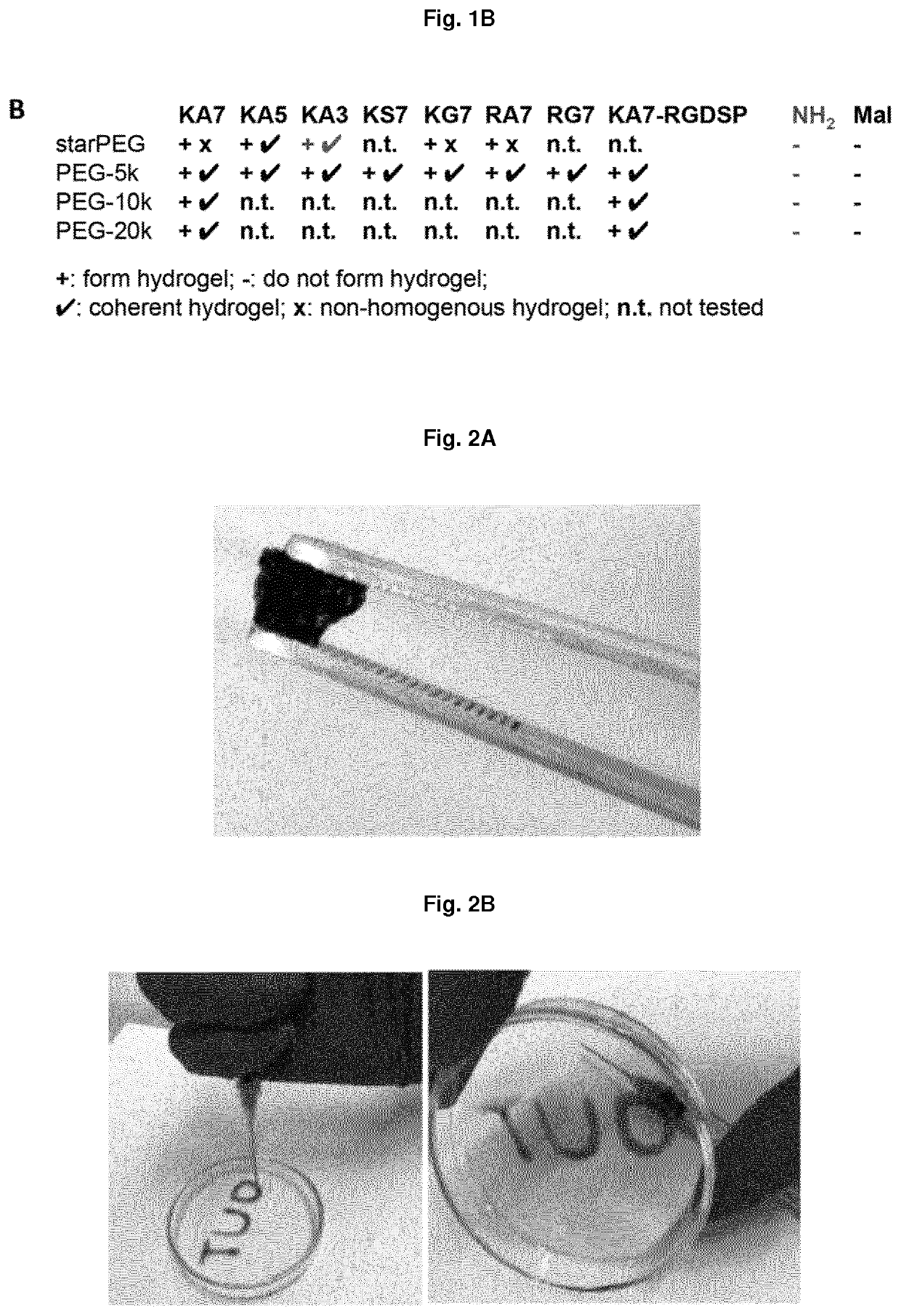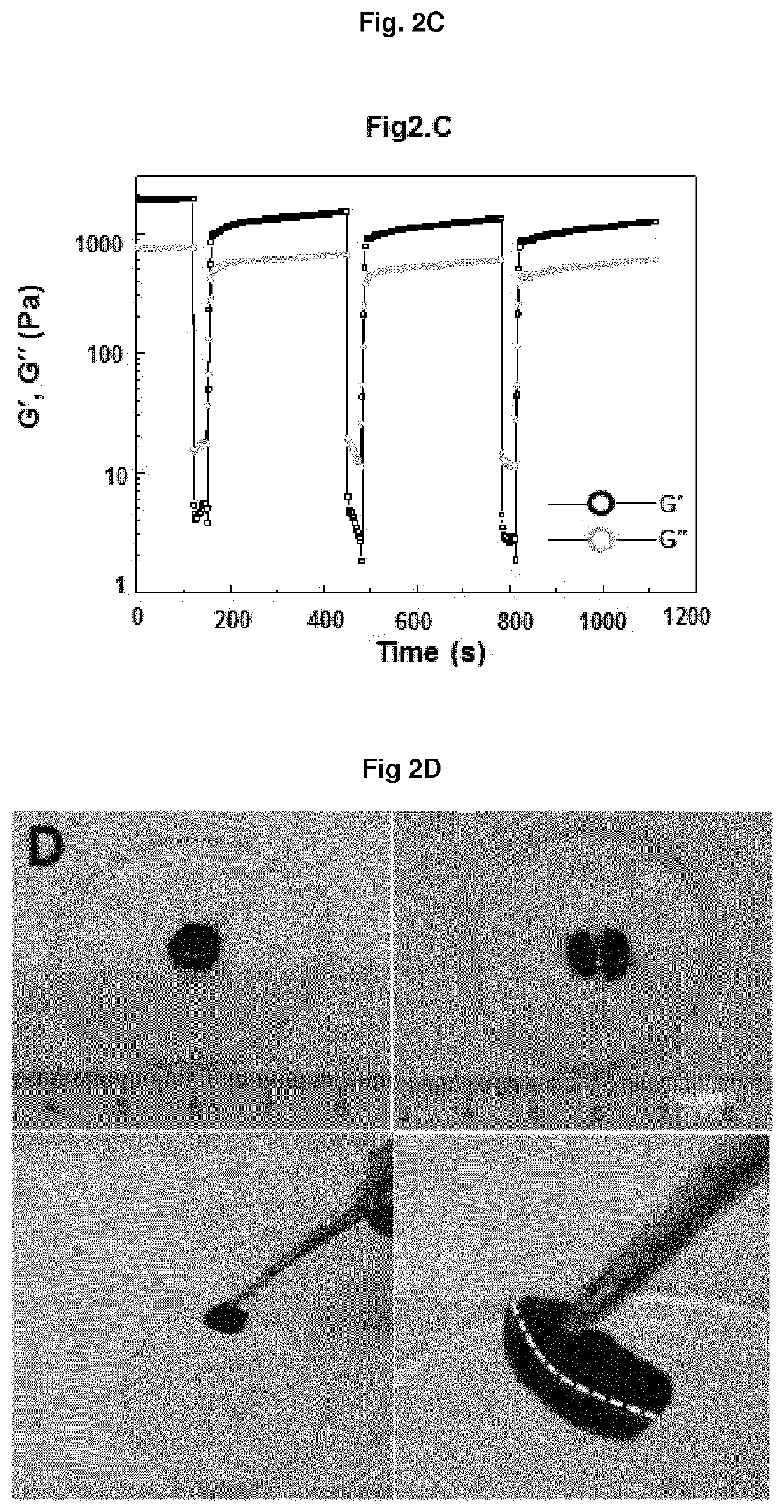Non-covalently assembled conductive hydrogel
a conductive hydrogel and non-covalent technology, applied in the direction of macromolecular non-active ingredients, capsule delivery, pharmaceuticals, etc., can solve the problems of limited optimal bio-integration, large mismatch between electronic components and native tissues, and complex methods for producing the same, etc., to achieve the effect of self-healing and molecular ordering
- Summary
- Abstract
- Description
- Claims
- Application Information
AI Technical Summary
Benefits of technology
Problems solved by technology
Method used
Image
Examples
example 1
YNTHESIS
[0175]All peptides mentioned herein are produced by utilizing a standardized-fluorenylmethoxycarbonyl chemistry (FMOC chemistry) on a solid phase with 2-(1H-benzotriazol-1-yl)-1,1,3,3 tetramethyluronoiumhexafluorophosphate-activation (HBTU-activation) in an automatic solid phase peptide synthesizer (ResPep SL, Intavis, Cologne, Germany). To obtain good peptide quality, each amino acid was coupled two times with the fivefold excess, wherein all non-reacting amino groups were protected with acetic acid anhydride. For cleaving the peptide from the resin, the resin was treated for one and one half hour with a mixture of trifluoroacetic acid (TFA) triisopropylsilane(TIS) / water / dithiothreitol (DTT), wherein these components are present in a ratio of 90 (v / v):2.5 (v / v):2.5 (v / v):2.5 (m / v).
[0176]The peptides were dissolved in water, which contained 2 mg / ml tris(2-carboxyethyl)phosphine (TCEP). The peptide purification was carried out by means of reverse-phase high pressure liquid ch...
example 2
OF PEPTIDE-PEG-CONJUGATES
[0178]The synthesis of the PEG-peptide-conjugates for use in the hydrogel self-organization were carried out through Michael-addition-reactions between maleimide-terminal four-armed PEG or maleimide-terminal linear PEG and cysteine-terminal peptides from the library. In the case of star-PEG, both components were dissolved in physiological phosphate buffer solution (1× PBS) with a pH value of 7.4 in a molar ratio of 1:4.5 (star-PEG:peptide) with a total concentration of 80 mg / ml. The reaction mixture was quickly covered and stirred at 750 rpm at room temperature for 18 hours (MR Hei-Standard, Heidolph, Schwabach, Deutschland) The raw products were analyzed through reverse-phase high pressure liquid chromatography (UPLC) (UPLC Aquity™ with UV detector, Waters, Milford, Mass., USA) by using C18 column (AQUITY™ UPLC BEH C18, grain size 1.7 μm, 50×2.1 mM, Waters, Milford, Mass., USA) and an isocratic gradient. The raw product was dialyzed with a dialysis membrane...
example 3
N OF THE HYDROGEL NETWORKS CONTAINING STAR-PEG AND HEPARAIN
[0179]14-kD-heparin (25 mM, 2.5 mM) and star-PEG-peptide conjugates (6.25 mM, 3.125 mM) were dissolved in physiologic phosphate buffer solution (1×PBS) water or cell culture medium with 2% fetal bovine serum (FBS). These solutions were dissolved in a ratio of 1:4 heparin:star-PEG-peptide-conjugate by obtaining 0.5 mM or 5 mM 14-kD-heparin and 2.5 mM or 5 mM star-PEG-peptide. The ligand / mol ratio was 2:1, 1:1 and 1:5 relative to the mol ratio of 14-kD-heparin and the star-PEG-peptide-conjugate. The mixtures were incubated within a time frame of one hour to overnight at room temperature of 37° C. The gelling time spanned from present up to several hours depending on the applied peptide motif. A hydrogel was formed when it survived the addition of physiological phosphate buffer solution (1×PBS) pH 7.4 to the mixture after the incubation of the mixture over the prior night without mixing with the added solution.
PUM
| Property | Measurement | Unit |
|---|---|---|
| conductive | aaaaa | aaaaa |
| adhesion | aaaaa | aaaaa |
Abstract
Description
Claims
Application Information
 Login to View More
Login to View More - R&D
- Intellectual Property
- Life Sciences
- Materials
- Tech Scout
- Unparalleled Data Quality
- Higher Quality Content
- 60% Fewer Hallucinations
Browse by: Latest US Patents, China's latest patents, Technical Efficacy Thesaurus, Application Domain, Technology Topic, Popular Technical Reports.
© 2025 PatSnap. All rights reserved.Legal|Privacy policy|Modern Slavery Act Transparency Statement|Sitemap|About US| Contact US: help@patsnap.com



